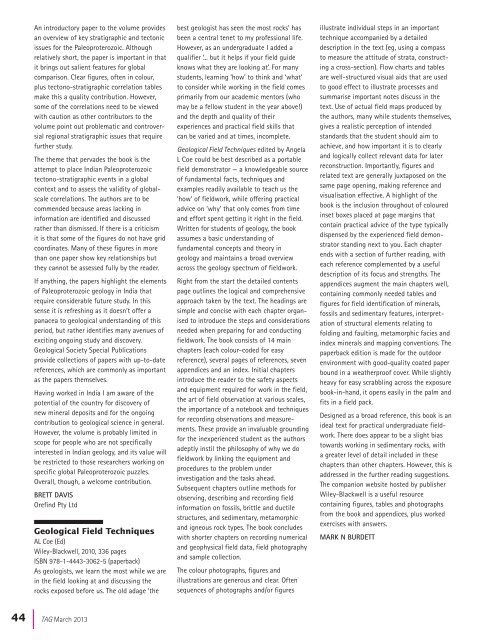TAG 166 - Geological Society of Australia
TAG 166 - Geological Society of Australia
TAG 166 - Geological Society of Australia
Create successful ePaper yourself
Turn your PDF publications into a flip-book with our unique Google optimized e-Paper software.
An introductory paper to the volume providesan overview <strong>of</strong> key stratigraphic and tectonicissues for the Paleoproterozoic. Althoughrelatively short, the paper is important in thatit brings out salient features for globalcomparison. Clear figures, <strong>of</strong>ten in colour,plus tectono-stratigraphic correlation tablesmake this a quality contribution. However,some <strong>of</strong> the correlations need to be viewedwith caution as other contributors to thevolume point out problematic and controversialregional stratigraphic issues that requirefurther study.The theme that pervades the book is theattempt to place Indian Paleoproterozoictectono-stratigraphic events in a globalcontext and to assess the validity <strong>of</strong> globalscalecorrelations. The authors are to becommended because areas lacking ininformation are identified and discussedrather than dismissed. If there is a criticismit is that some <strong>of</strong> the figures do not have gridcoordinates. Many <strong>of</strong> these figures in morethan one paper show key relationships butthey cannot be assessed fully by the reader.If anything, the papers highlight the elements<strong>of</strong> Paleoproterozoic geology in India thatrequire considerable future study. In thissense it is refreshing as it doesn’t <strong>of</strong>fer apanacea to geological understanding <strong>of</strong> thisperiod, but rather identifies many avenues <strong>of</strong>exciting ongoing study and discovery.<strong>Geological</strong> <strong>Society</strong> Special Publicationsprovide collections <strong>of</strong> papers with up-to-datereferences, which are commonly as importantas the papers themselves.Having worked in India I am aware <strong>of</strong> thepotential <strong>of</strong> the country for discovery <strong>of</strong>new mineral deposits and for the ongoingcontribution to geological science in general.However, the volume is probably limited inscope for people who are not specificallyinterested in Indian geology, and its value willbe restricted to those researchers working onspecific global Paleoproterozoic puzzles.Overall, though, a welcome contribution.BRETT DAVISOrefind Pty Ltd<strong>Geological</strong> Field TechniquesAL Coe (Ed)Wiley-Blackwell, 2010, 336 pagesISBN 978-1-4443-3062-5 (paperback)As geologists, we learn the most while we arein the field looking at and discussing therocks exposed before us. The old adage ‘thebest geologist has seen the most rocks’ hasbeen a central tenet to my pr<strong>of</strong>essional life.However, as an undergraduate I added aqualifier ‘... but it helps if your field guideknows what they are looking at’. For manystudents, learning ‘how’ to think and ‘what’to consider while working in the field comesprimarily from our academic mentors (whomay be a fellow student in the year above!)and the depth and quality <strong>of</strong> theirexperiences and practical field skills thatcan be varied and at times, incomplete.<strong>Geological</strong> Field Techniques edited by AngelaL Coe could be best described as a portablefield demonstrator — a knowledgeable source<strong>of</strong> fundamental facts, techniques andexamples readily available to teach us the‘how’ <strong>of</strong> fieldwork, while <strong>of</strong>fering practicaladvice on ‘why’ that only comes from timeand effort spent getting it right in the field.Written for students <strong>of</strong> geology, the bookassumes a basic understanding <strong>of</strong>fundamental concepts and theory ingeology and maintains a broad overviewacross the geology spectrum <strong>of</strong> fieldwork.Right from the start the detailed contentspage outlines the logical and comprehensiveapproach taken by the text. The headings aresimple and concise with each chapter organisedto introduce the steps and considerationsneeded when preparing for and conductingfieldwork. The book consists <strong>of</strong> 14 mainchapters (each colour-coded for easyreference), several pages <strong>of</strong> references, sevenappendices and an index. Initial chaptersintroduce the reader to the safety aspectsand equipment required for work in the field,the art <strong>of</strong> field observation at various scales,the importance <strong>of</strong> a notebook and techniquesfor recording observations and measurements.These provide an invaluable groundingfor the inexperienced student as the authorsadeptly instil the philosophy <strong>of</strong> why we d<strong>of</strong>ieldwork by linking the equipment andprocedures to the problem underinvestigation and the tasks ahead.Subsequent chapters outline methods forobserving, describing and recording fieldinformation on fossils, brittle and ductilestructures, and sedimentary, metamorphicand igneous rock types. The book concludeswith shorter chapters on recording numericaland geophysical field data, field photographyand sample collection.The colour photographs, figures andillustrations are generous and clear. Oftensequences <strong>of</strong> photographs and/or figuresillustrate individual steps in an importanttechnique accompanied by a detaileddescription in the text (eg, using a compassto measure the attitude <strong>of</strong> strata, constructinga cross-section). Flow charts and tablesare well-structured visual aids that are usedto good effect to illustrate processes andsummarise important notes discuss in thetext. Use <strong>of</strong> actual field maps produced bythe authors, many while students themselves,gives a realistic perception <strong>of</strong> intendedstandards that the student should aim toachieve, and how important it is to clearlyand logically collect relevant data for laterreconstruction. Importantly, figures andrelated text are generally juxtaposed on thesame page opening, making reference andvisualisation effective. A highlight <strong>of</strong> thebook is the inclusion throughout <strong>of</strong> colouredinset boxes placed at page margins thatcontain practical advice <strong>of</strong> the type typicallydispensed by the experienced field demonstratorstanding next to you. Each chapterends with a section <strong>of</strong> further reading, witheach reference complemented by a usefuldescription <strong>of</strong> its focus and strengths. Theappendices augment the main chapters well,containing commonly needed tables andfigures for field identification <strong>of</strong> minerals,fossils and sedimentary features, interpretation<strong>of</strong> structural elements relating t<strong>of</strong>olding and faulting, metamorphic facies andindex minerals and mapping conventions. Thepaperback edition is made for the outdoorenvironment with good-quality coated paperbound in a weatherpro<strong>of</strong> cover. While slightlyheavy for easy scrabbling across the exposurebook-in-hand, it opens easily in the palm andfits in a field pack.Designed as a broad reference, this book is anideal text for practical undergraduate fieldwork.There does appear to be a slight biastowards working in sedimentary rocks, witha greater level <strong>of</strong> detail included in thesechapters than other chapters. However, this isaddressed in the further reading suggestions.The companion website hosted by publisherWiley-Blackwell is a useful resourcecontaining figures, tables and photographsfrom the book and appendices, plus workedexercises with answers.MARK N BURDETT44 |<strong>TAG</strong> March 2013
















